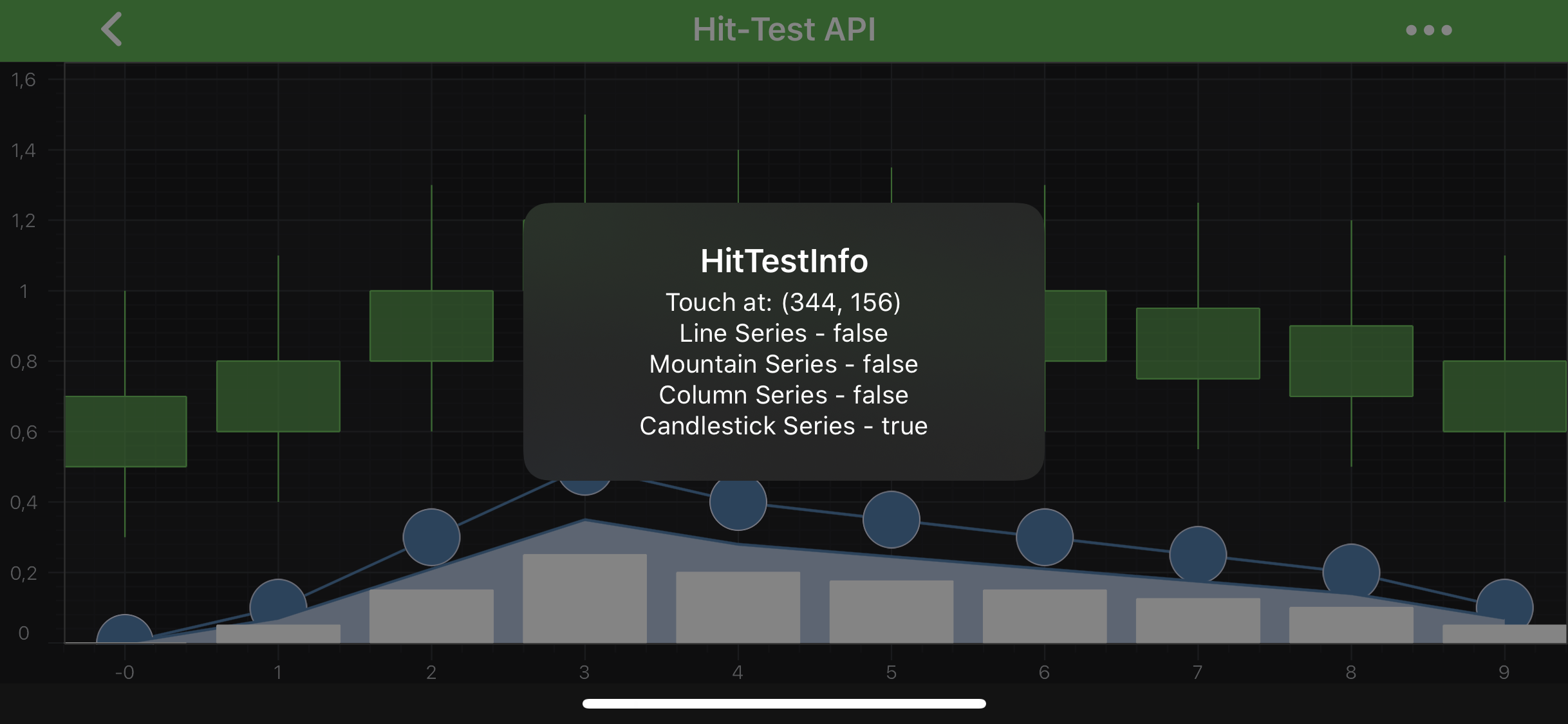
iOS & macOS Charting Documentation - SciChart iOS & macOS Charts SDK v4.x
Hit-Test API
The Hit-Test API is a set of virtual methods defined on ISCIRenderableSeries such as:
-[ISCIRenderableSeries hitTest:at:].-[ISCIRenderableSeries hitTest:at:withHitTestRadius:].-[ISCIRenderableSeries verticalSliceHitTest:at:].
This API is used by the SCIRolloverModifier, SCITooltipModifier, SCICursorModifier and SCISeriesSelectionModifier to transform touch on screen into data-points, and determine if touch event occurs over a point or over a series.
To call the Hit-Test method, use the following code:
NOTE: You must transform any touch events into the coordinate space of the main chart area. Without this, all hit-test results will be inaccurate. You can learn more about it in the Axis APIs - Convert Pixel to Data coordinates article.

NOTE: You can see hit-test in action, in our full Hit-Test API example, which be found in the SciChart iOS Examples Suite as well as on GitHub:
The Hit-Test Results
The SCIHitTestInfo which is used for Hit-Test contains some useful properties to determine what point was touched.
| Property | Description |
|---|---|
SCIHitTestInfo.hitTestPoint |
The coordinates of a point, that is used for Hit-Test. |
SCIHitTestInfo.hitTestRadius |
The Hit-Test radius which was used for searching of nearest data point. |
SCIHitTestInfo.dataSeriesIndex |
If data point that was hit contains the index of the point in ISCIDataSeries which was hit. |
SCIHitTestInfo.pointSeriesIndex |
If data point that was hit contains the index of hit test point in associated ISCISeriesRenderPassData. |
SCIHitTestInfo.isHit |
Boolean flag which tells whether or not SCIHitTestInfo.hitTestPoint was within a certain radius of point on a series. |
SCIHitTestInfo.isWithinDataBounds |
Boolean flag which tells if SCIHitTestInfo.hitTestPoint lies between first and last X point on series. |
SCIHitTestInfo.hitRenderableSeries |
The ISCIRenderableSeries which we perform Hit-Test on. |
UseInterpolation Flag
The UseInterpolation flag increases the accuracy of the Hit-Test at the expense of performance. You can modify its value via the SCITooltipModifierBase.useInterpolation property, which is available for all the inheritors such as SCITooltipModifier, for example.
Consider SCIFastLineRenderableSeries and it’s possible interpolation cases:
useInterpolation = NO- hit-test will returnSCIHitTestInfo.isHit= YES - only if the input mouse-point is over a data-point.useInterpolation = YES- hit-test will returnSCIHitTestInfo.isHit= YES - if the input touch event is over the line.
This is useful say if you wanted to show a tooltip only on data-points (useInterpolation = NO) vs. anywhere on the line (useInterpolation= YES).
For other series types, such as SCIFastCandlestickRenderableSeries, SCIFastColumnRenderableSeries, SCIFastMountainRenderableSeries, using useInterpolation = YES will result in an isHit = YES when touch is over the series as opposed to over the data-points.
NOTE: The interpolation is linear and linear only at the time of writing, it is not suitable for use by Logarithmic Axis.
 View on GitHub
View on GitHub